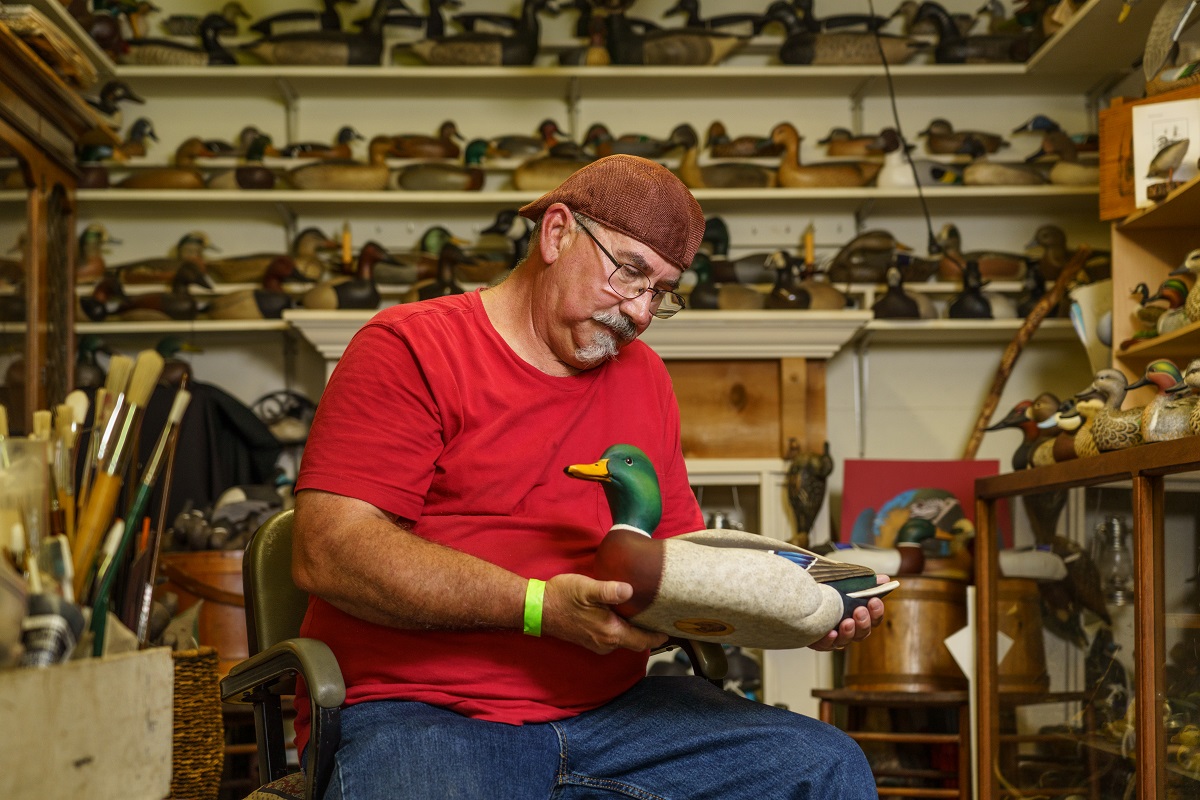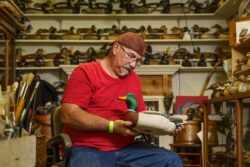Coastal
Decoy Dynasty
The unsung art of duck decoy carving
Published: September 1, 2020
Last Updated: December 10, 2020

Photo by Zack Smith
The hand–crafted, hand-painted ducks created by carver Carl Danos have a bit more flash than other decoys.
His preening birds hold thinly carved feathers in their mouths. His resting birds, with their heads tucked, have elegantly curved necks and are painted more vividly, with intricately carved lines marking the edges of individual feathers.
Danos, seventy-one, also has a little extra flash. During a duck-decoy showcase held last summer at the Bluebonnet Swamp Nature Center in Baton Rouge, he walked in with a mane of carefully coiffed white hair, a neatly clipped goatee beard, and an unbuttoned shirt showing off two gold chains, one with a gold duck pendant.
Some of the younger carvers call him “the godfather” for his stylishness and for his command of their craft, which has earned him national and worldwide acclaim. Though Historic New Orleans Collection curators have found decoy traditions associated with each of the North American migratory flyways, Danos believes that the Mississippi flyway, bolstered by the Cajun tradition of decoy carving, gets bragging rights for its dominance at national shows. “Louisiana always kicks butt,” he said.
Danos’s family says that his artistry may have also saved his life, since he has relied on it to keep his blood pressure low after undergoing open-heart surgery in 1984.
Like the wild birds he knows best, Carl Danos most often travels as part of a pair, with his baby brother and fellow carver Reagan Danos, sixty-one. Since 1975 the brothers have lived a few steps from each other in neighboring houses in Larose. Reagan is the more understated brother, typically dressed in a t–shirt and jeans, with closely shaved hair.
They’re now considered master carvers, who have been carving for forty years on their off days, from Reagan’s work in the oil–field industry and from Carl’s work as a butcher.
The history, as told to Carl Danos, is that the Acadians who moved into the marshlands of Louisiana learned to carve decoys from American Indians, who notably went a step further by lying in the water next to their decoys, breathing through marsh reeds until a duck got close enough to grab for dinner.
Cajuns who survived off the land around them learned to make decoys as a practical craft, to lure ducks within range of duck blinds. But at some point around 1960 hand-crafted decoys became more of a nicety than a necessity, according to the catalogue for The Historic New Orleans Collection’s 2008 decoy exhibition Birds of a Feather.
Louisiana carvers refer to decorative decoys, ones made for collectors, as “shelf pieces.” In 2007 two such decoys, a preening pintail drake and a sleeping Canada goose carved by Massachusetts carver A. Elmer Crowell, sold for $1.13 million each in a private sale. Vintage decoys, sometimes with shotgun-pellet marks from use in Louisiana swamps, now routinely sell for several thousand dollars on eBay.
Today, most working decoys are plastic. Still, even when most wooden decoys were working decoys, some carvers were recognized for artistic touches such as eerily realistic painted and incised feathers as well as eyes made with brown beer-bottle glass. In tight-knit Lafourche Parish everyone knows about the history of legendary Lafourche carvers. People like Clovis “Cadice” Vizier from Galliano, who won a national championship in 1951, and Reme Roussel from Raceland, who never left home without a knife and some wood so that he could carve while visiting a neighbor’s porch or when sitting in the barbershop.
The Danos brothers still live along Bayou Lafourche, where they grew up about four miles away in the town of Cut Off. Their dad, Anthony “Cowan” Danos, was a fisherman who shrimped, crabbed, and oystered as well as taught his children how to make a pirogue, the shallow, flat-bottomed Louisiana boats. Their mother, Clara Mae Danos, was a natural artist: a talented seamstress who also liked to carve miniature shelf decoys. Their father left the carving to others in his family, though he prepared freshly cut tupelo wood for them. “We’d bring trees to his house, and he’d clean off all the mud and square off each piece of wood,” Reagan Danos said.
They now realize that their father also played a key psychological role in sharpening their skills by heightening their sibling rivalry. “My father was a boss, a finger-pointer, a pusher,” Reagan Danos said, recalling how his dad would wake up early and have coffee with whichever brother was up first. To the brother who had slept in, their father would often say, “Your brother got you beat.”
Carl Danos believes that there is a duck in every block of wood. “My job is to see the duck and bring it to life,” he said.
Both brothers follow the same process. First, they sketch out the bird’s body on paper. Then they grab a block of wood and use a band saw to cut out the bird’s shape using the drawing as a guide. From there, they rely on hand tools to shave and shape. “Sometimes, I just want to use a knife,” Reagan Danos said. “Just the feel of carving, it’s relaxing.”
The carving can take a few hundred hours over months of time, the brothers say. Painting spans a few days as they use small brushes to make detailed strokes that portray individual feathers sometimes dotted with tiny glints of color. Though the results are often gorgeous, it’s an effort wasted on ducks, which are color–blind, Reagan Danos said. Once the paint dries, they add strategically placed lead weights to ensure the decoy floats correctly. Finally, they turn over the bird and sign it on the bottom, their name carved in bold capital letters.
The Danos brothers are proud to put their names onto their decoys. For Carl Danos, their craft far transcends traditional folk art. “Decoy carving and jazz are the only two art forms that originated in the US. They belong to us,” he said.
Danos pounds his chest with his right hand to emphasize his point. “This is our culture,” he said. “This is our history.”
Katy Reckdahl is a New Orleans-based news reporter who is a frequent contributor to the Times-Picayune | New Orleans Advocate and WDSU special broadcasts. Her stories have appeared in the New York Times, National Geographic, the Atlantic, Next City, and the Christian Science Monitor.
 This article was made possible by the BHP-funded project, Coastal Impacts: An Integrated Approach for Community Adaptation, Understanding, and Planning, which will assist local communities to build intergenerational coastal literacy through community conversations around books, film, and exhibitions, fostering greater understanding of and support for coastal restoration projects.
This article was made possible by the BHP-funded project, Coastal Impacts: An Integrated Approach for Community Adaptation, Understanding, and Planning, which will assist local communities to build intergenerational coastal literacy through community conversations around books, film, and exhibitions, fostering greater understanding of and support for coastal restoration projects.
